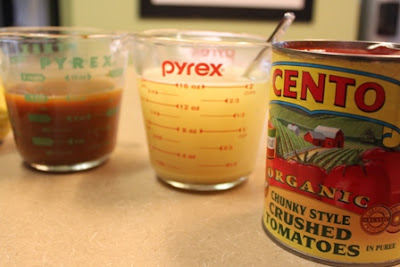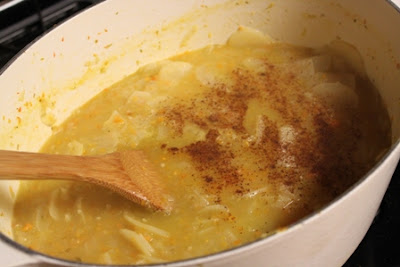Longest. Title. Ever. But what else was I supposed to name this? I made two recipes, an entree and a lovely side dish that I can't wait to eat as leftovers. My friend Paulina gave me the inspiration for this recipe. She posts on FB about her cooking, and my husband likes to always point them out to me. Her latest salivating dinner she posted about was Lobster Pot Pie. Doesn't that sound delish? I ran into Paulina the other day and asked her about the Lobster Pot Pie, and then she mentioned in our conversation that she made Veal Chops in a Mustard Sage Sauce for Valentines Day. Yum! I knew this would be my next meal!
I had some poblano peppers in the house that needed to be used up, so I jumped online to see what new recipe I could make with these peppers to accompany the Veal. I found this Blue Ribbon Recipe for
Poblano Potato Gratin on Epicurious, one of thier highest ranked recipes of all time. It comes from a 2008 issue of Gormet magazine and I just happened to have all the ingredients on hand. Lovely!
For the Gratin, you will need:
1 1/2 pounds fresh poblano chiles (about 5)
1 pound onions, cut lengthwise into 1/4-inch strips
1 tablespoon vegetable oil
3 pounds large Yukon Gold potatoes
1 1/2 cups heavy cream
3/4 cup whole milk
I added:
1 teaspoon Salt
1 teaspoon White Pepper
1/2 teaspoon Ground Mustard
Scant dash of Cayenne Pepper
The first thing we need to do is burn the crap out of the poblano peppers. I char mine right on the gas stove. Alternatively, you can put these under the broiler in the oven. Turn every couple of minutes to get them black all over.
Next, put the peppers in a zip top bag and let them steam for at least 10 minutes. You could also put them in a bowl and cover tightly with plastic wrap.
While the peppers steam, slice the onion from root to tip.
Set over medium heat with a splash of olive oil or vegetable oil. This step cannot be rushed. Let the onions cook down for 15 or 20 minutes, stirring often and adding in more oil if the pan gets too dry. We are waiting for them to fully caramelize and turn a dark brown color.
Meanwhile, let's slice the potatoes! Peel them first, and then using a mandolin, slice the potatoes as thin as possible.
I found that putting the slices in a big bowl of water helps rinse the extra starch from them and also prevents them from turning brown.
Now that the poblano peppers have steamed, give them a good rub to easily remove the blackened skin.
Remove the seeds and membrane from the inside.
Then simply slice these into thin strips.
Add the poblano pepper strips to the caramelized onions. Stir to combine, then remove from heat and set aside.
I used my dutch oven to cook the potatoes with the cream and milk over medium heat. Bring it to just a boil, and stir often to prevent any milk from burning on the bottom. The mixture will thicken as it heats up.
I added a few of my own seasoning additions. 1 teaspoon Salt, 1 teaspoon White Pepper, 1/2 teaspoon Ground Mustard and a scant dash of Cayenne Pepper.
Generously butter a 3 quart baking dish.
When the milk comes to a boil, turn off heat and you can either add the onion and poblano mixture to the milk and potatoes... or...
You can add them in layers to the baking dish like I did.
I wanted to ensure the ingredients were evenly distributed, so I started with a thin layer of potatoes on the bottom, then topped with the onions and poblano peppers, then added more potatoes...
Until I dumped the rest of the milk and onion mixture on top. Bake in a 400 degree oven for 45 minutes to an hour.
Everything gets brown and bubbly! Let this rest for 10 minutes before cutting into it.
Oh yum! I love how the sauce thickens and the potatoes are soft and the onion and poblano peppers so flavorful! Next time, I will ty adding a layer of Parmesan cheese in the middle and/or on top. I thought the gratin could use a little salt and in my opinion and the cheese would have supplied that salt flavor and act as a bit of a binder. I completely understand why this recipe is a Blue Ribbon Recipe.
I served this potato side dish along with
veal cutlets in a rich mustard and sage sauce. Here is how I made the veal...
I first seasoned the meat with salt and pepper, then dredged in a bit of flour. You could then, dredge in egg and then a crunchy coating, but I wanted to keep these simple because the sauce is AWESOME!
I used the same pan that I cooked the onions and poblano peppers in. Add a tablespoon of butter to melt over medium-high heat.
Then, this picture is a fast forward photo of the finished product (I moved quickly and forgot to take pics, shame on me) Here is what you missed: I browned the veal on both sides, maybe a total of 4 minutes (not long) then removed them to a plate and tented with foil to keep warm.
Add about two tablespoons of minced shallots to same skillet and stir 1 minute. Add 1/3 cup beef broth, 1 tablespoon minced sage and two tablespoons of mustard to the skillet and bring to a low boil until very thick, scraping up browned bits, about 4 minutes.
Add 1/3 cup of half and half and boil until liquid thickens to sauce consistency, about 1 minute. Mix in remaining 1 tablespoon minced sage, add back the veal along with any juices exuded by the meat. Adjust seasoning. Place one cutlet on each plate and spoon sauce over.
Pair this with a nice salad (like the
spicy caesar salad I made) and you have a really wonderful and flavorful dinner. Oh, Jim and I really enjoyed this!
My recipe inspirations:

































































